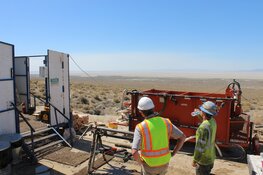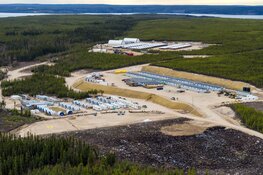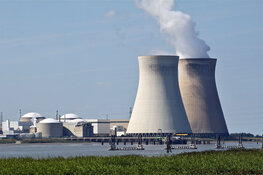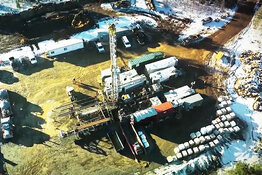Marin Katusa: When looking at the energy sector, one must start with petroleum, as that alone is a very large sector. Brent Crude is currently trading at a premium to WTI (West Texas Intermediate), mainly because of a political instability premium based on what's happening in the Middle East. Speculators have propped up the prices because of the amount of demand required from Europe, which comes from the Middle East. The WTI price has lagged as the differentials increased since February because of the Middle East turmoil.
That said, in the last three weeks you've seen a significant pullback on the petroleum sector market-wide, in the spot price of the oil and equities in both big caps and the juniors. The main reasons are the weak economy and the U.S. Energy Information Administration report stating, "$100+ per barrel (bbl.) oil is just too much of a burden in this fragile economy." That brings out the speculators, which comprises a 20%-25% premium in petroleum. Another reason for a big drop in the price of oil is that the United States is leading an international effort to release 60 million barrels (MMbbl.) of crude reserves to world markets.
TER: Natural gas is a little different story, isn't it?
MK: Natural gas is a very localized market. If you look at North America, because of the success of the unconventional technologies, mainly shale fracking, the companies are a victim of their own success. Because these unconventional explorers have been so successful in finding unconventional sources of gas, there is a glut of gas. But that, too, shall pass as the cure for low prices is low prices. It's just going to take some time—more time than most investors are willing to wait. We wrote a report a couple of years ago called, "The Hidden U.S. Supply of Gas." It shined a light on the thousands of uncompleted wells that are drilled, but not completed and could be tapped into the pipeline structure in 72 hours if they were viable. You're going to see sideways gas for the next 6-12 months in North America, and over the next 3 months you could see petroleum sideways to down.
TER: How about uranium in light of Fukushima?
MK: The uranium sector had a big fall, obviously, since the Fukushima disaster. Ironically, mainly by fluke, about 2.5 weeks before Fukushima, in our newsletter and on TV, we came out with a "take profits" opinion on the uranium sector mainly because we went very bullish on it eight months before. I think when this whole cloud has settled down, you're going to see some really interesting buying opportunities in a few very select uranium companies.
The uranium companies you want to stick with are the lowest cost producers with no debt and explorers with tangible, real deposits that are very high-grade in areas of developed infrastructure (a pro-uranium mining culture helps) with defined resources within the NI 43-101 standard that look like take-out targets. You want to stay away from the early stage exploration projects in areas that lack infrastructure. The smart money is staying away from those types of projects. In my opinion, those projects are going to go sideways to down because explorers will always need to raise money to explore.
It's a fact that the U.S. is the largest consumer of uranium, but the country only produces about 8% of that domestically. It purchases the rest. So there's still plenty of existing demand. The uranium story isn't dead, but an investor has to be much more careful in choosing investments. I'd also stay away from thorium. It's shocking how many emails I get about thorium. We've written about all the reasons to stay away from thorium quite a bit in our Casey Energy Report.
Back to uranium, you've got Germany, where Chancellor Angela Merkel just said, "We're going away from nuclear power" and the Japanese are saying the same. But you've got the RISC countries—Russia, India, South Korea, and China—and they're going nowhere. They're going to stick with the uranium demand that they have, and it will increase (they will be building nuclear plants fueled with uranium, not thorium).
TER: And what about geothermal?
MK: Now, the geothermals have taken a significant hit back, even though the current PPAs (power purchase agreements) provide significant profits. The actual public companies have taken a big fall following the Ram Power Corp. (TSX:RPG) disaster where they missed their wells and had cost overruns. Geothermal is currently a contrarian investment opportunity where these geothermal companies are trading at a fraction of what they were a year ago. I just wrote an article called "The Valley of Darkness" comparing the current geothermal sector to the copper sector in late 2008.
TER: So you think oil prices will be sideways in the next year because the market can't sustain these kinds of prices. Is that correct?
MK: If the Arab Spring does shift—and the key here is whether Saudi Arabia falls—you will see $150-$200/bbl. oil overnight. If something were to happen to the flow from the massive Ghawar oil field in Saudi Arabia, that would result in the single largest increase in oil prices the world has ever seen. Otherwise, oil is sideways to down. My point is that we really are on the edge of chaos. Saudi Arabia is very important to keeping oil below $150/bbl.
TER: You mentioned the possibility of opening up fracked natural gas wells. Is that going to go crazy any time soon?
MK: A moratorium exists on a lot of new shale gas wells due to concerns about water supplies. We did a report a few years ago where we talked about how an unconventional well uses between 2 and 5 million gallons of water, of that you get back roughly half. The Marcellus Shale, the Utica Shale, the Paris Basin—all of these basins have moratoriums on them because some people are worried about polluting the water table. The fracking occurs many thousands of meters below the water table so I think it is a misplaced fear, but you're dealing with politicians and NGO groups, so you aren't really dealing with facts or science. If these groups are successful, further moratoriums could be imposed, but it would be a crying shame if these moratoriums extended into the Haynesville Shale in Louisiana or the Eagle Ford Shale in Texas. I don't suspect we will see this happen, but if it did, you would see a significant pop in the price of domestic natural gas.
TER: Going to nuclear now, despite the Fukushima disaster, nuclear power is here to stay. How much effect is the current controversy over nuclear safety going to have on new plant development currently in the works?
MK: Global demand will be affected by countries such as Germany and Japan. They still have existing plants; remember they're going to be operating until 2022, in the case of Germany. A lot of this is political lip service; they're giving the people what they want to hear now. What are the Germans going to replace that production with?
TER: Well, maybe they think they can do it with solar?
MK: I don't think so. They're importing nuclear energy across the border from France. So, this is just political lip service. The politicians just want to stay in power long enough to get their juicy pensions. They don't care about—or even if they did care, they aren't able to find—real solutions, that is why they are politicians. I believe that before 2022 rolls around, the Germans will rethink their nuclear position. But remember, you have more than 20 nuclear plants being built in China; you've got South Korea, Russia and India looking to develop. So let's just imagine that Germany and Japan do close down, whatever they shut down is going to be replaced by growth in other countries.
TER: Who will benefit from continued demand for uranium? Which uranium stocks do you think are going to continue to be attractive under the current scenarios?
MK: Let's start with Uranium Energy Corp (NYSE.A:UEC), one of the lowest cost producers in the world. It has been a big win for our subscribers a few times, and it is a new producer led by Amir Adnani, who is in our "Ten bagger" club—a club for companies that delivered 1000+% gains for our subscribers.
I also like Denison Mines Corp. (TSX:DML; NYSE.A:DNN) a lot. It has production in the U.S. and access to a mill in the Athabasca Basin, which hosts one of the highest grade uranium projects on the planet. They made a major discovery at their Phoenix deposit—a very, very high-grade deposit. So, that's a blend of low-cost production and high-grade deposits. We have a lot of technical research on both of these companies on our website at www.caseyresearch.com , as we've been to their projects, and our subscribers have done well on both of these companies.
If you want a higher risk story, we like Hathor Exploration Ltd. (TSX.V:HAT). We have had that in our portfolio for many years and they've made a great discovery of a high-grade deposit. So those are the three that we have in our Casey Energy Report that we follow.
TER: Any new developments with those companies?
MK: Uranium Energy Corp. has hit the numbers that they gave the public regarding production costs and are actually lower than originally stated—less than $18/lb. The company is growing production to 1 Mlb. annually. It's very important to know that yes, the spot price of uranium has taken a big hit, but the spot market price is still north of $50/lb., and the long term price trades north of $70/lb. The netback—the differential between what the selling price and the production costs—are still very impressive profits.
TER: Any other juniors you think have merit at this point?
MK: In our Energy Confidential, we really like Fission Energy Corp. (TSX.V:FIS; OTCQX:FSSIF), which is adjacent to the Hathor deposit. The play there is that we believe that Hathor will buy out Fission so that they can have a large consolidated resource. At that point, we think Hathor will have over 60 Mlb. of very high-grade uranium. From there we believe the play would be that Denison will buy out the combined Hathor and Fission company.
The ultimate end game in the Athabasca Basin, we believe, would involve BHP Billiton Ltd. (NYSE:BHP; OTCPK:BHPLF). There's good potential that they want access into the Athabasca Basin, and the only way that they can do that would be through access to a mill. It's very difficult to get the permits to build a mill in the Athabasca Basin. Either it buys out Cameco Corp. (TSX:CCO; NYSE:CCJ), which is not going to happen; or the big French uranium company AREVA (PAR:CEI), sells an interest, which is not going to happen; or it buys Denison Mines, which owns a percentage of an operating mill.
So the key to the play there for the juniors like Hathor and Fission is to be bought out by a larger company. That's why we like Fission, it has good management that discovered a very good project.
TER: The geothermal sector is obviously quite a bit smaller than the other energy sectors, but people are taking another look there also. There seems to be a lot of potential out there, but it's not so easy to capitalize on it. What's going on with the companies that you follow there?
MK: In our Energy Opportunities Newsletter, we follow Ormat Technologies Inc. (NYSE:ORA), the world's largest, pure-play geothermal company. If you want lower risk, you probably want to stick with Ormat. If you've got an appetite for a higher risk junior, we think Alterra Power Corp. (TSX:AXY), which is Ross Beaty's deal, is a good play. It's the old Magma Energy merged with Plutonic Power Corp. Alterra just received $70M+ cash from the sale of a portion of their Iceland asset. They're very sound; they make money. It's one of the few junior companies that can stay afloat because it actually makes money. It has a sustaining business and Ross Beaty has done a great job building that. Don't ever count out Ross Beaty, the guy is a legend. In time, he will build AXY into a winner. Investors have to be patient; the geothermal sector right now isn't the place for fast money.
Ram Power seems to be fixing itself up here. It fell on its knees when founder and President Hezy Ram left after missing targets and cost overruns. The company has restructured the management, refinanced it and so far the results look promising. It still has to build up its San Jacinto plant and the geysers seem to be going on track. So, time will tell with Ram. It's been very disappointing, but so far, it seems like they're headed in the right direction.
Nevada Geothermal Power Inc. (TSX.V:NGP; OTCBB:NGLPF) has built the largest geothermal plant in the U.S. in the last decade. The company just bought out some Iceland assets in California. The geysers and the joint venture with Ormat on the Crump Geyser property in Oregon is moving as expected. So, all of these companies are doing the right things now, except the market is not reflecting it because no one really cares about it. It's the unloved energy sector. The companies are cheap, but their time will come. We don't know when it will happen, but because it is such a small sector, there are only a handful of companies, so when it does get attention these stocks are going to trade up multiples from where they are today.
TER: Years ago I visited the Geysers geothermal production facilities northeast of San Francisco. Who owns that now?
MK: I believe you are talking about the facilities about 100m northeast of San Francisco that are owned by Calpine Corp. (NYSE:CPN). The geysers are the largest group of geothermal plants in the world and Calpine has some good assets and production, but geothermal production is a very small percentage of Calpine's overall electricity production. Their main electricity plants are natural gas. It's a very large company; they've done very well, and they've got a good portfolio of geothermal assets.
TER: So, that's not a clean geothermal play by any means.
MK: No, and that's why we've avoided Calpine. If you want exposure to the geothermal sector, that's not the one you want to be in.
TER: Are there any other companies you would like to bring up at this point that you think our readers should be looking at?
MK: I think in general you want to stick with management teams that are proven; they've done it before; they're heavily invested in the companies themselves and they have a focus factor. One of my favorite companies right now is a company called East West Petroleum Corp. (TSX.V:EW). The company just signed a massive deal in Romania with a large energy company called NIS, which is more than half owned by the Russian gas company Gazprom. NIS is going to drill 12 wells on their unconventional gas assets in Romania, which is over US$50M worth of exploration on EW 100%-owned assets over the next 24 months. The company also signed a deal in India with three of the four largest Indian energy companies and has a deal in the Middle East with one of the largest independent oil producers, Kuwait Energy Corp. You want to stick with a company whose management team can attract a major company and use the major company's money to develop the assets that they own. It's kind of like the joint venture model in mining, the OPM, where you use other people's money. East West is a company we really like, and own a lot of shares.
Another one we really like is Niko Resources Ltd. (TSX:NKO). It's a much larger company, but we believe in the next 12-18 months they're going to have a lot of news coming out on their drill programs. In this market, it's time to pick your favorite stocks and be patient; put in your stink bids and see if you get a hit. Unfortunately, the company has recently gotten itself into some trouble that will cost it about CASD$10M-CAD$12M in fines. That's very disappointing, but the assets sure look good.
TER: Yes, it's summertime and nobody cares about the market.
MK: It's also the time to be accumulating your favorite stocks on sale. Buy on fear; sell on greed.
TER: Do you have any other thoughts you would like to leave with our readers?
MK: I think the reality of the sector is, regardless of what happens with the equities in the near term, if you're patient, the solid companies will grow their assets and either produce higher cash flows or get bought out by a major who needs to replace reserves. So, just because the market right now has a lot of negative sentiment, we look at this as a buying opportunity to pick up more shares of your favorite companies. They're on sale right now. Fortune favors the bold. Just make sure you do your homework and control your emotions. Don't let the fluctuations in the stock price take a toll in your personal life. Don't invest more than you can afford to lose. Juniors stocks are risky, but if invested in the right management teams, the risk is definitely worth the potential rewards.
TER: That's certainly true. Thanks for taking time out of your busy schedule to talk with us today. We appreciate your thoughts and input and hopefully our readers will also find them useful.
MK: Thanks for the opportunity.
Investment Analyst Marin Katusa is the senior editor of Casey's Energy Report, Casey's Energy Opportunities and Casey's Energy Confidential. He left a successful teaching career to pursue what has proven an equally successful—and far more lucrative—career analyzing and investing in junior resource companies. With a stock pick record of 19 winners in a row—a 100% success rate last year—Marin's insightful research has made his subscribers a great deal of money. Using his advanced mathematical skills, he created a diagnostic resource market tool that analyzes and compares hundreds of investment variables. Through his own investments and his work with the Casey team, Marin has established a network of relationships with many of the key players in the junior resource sector in Vancouver. In addition, he is a member of the Vancouver Angel Forum, where he and his colleagues evaluate early seed investment opportunities. Marin also manages a portfolio of international real estate projects.
Want to read more exclusive Energy Report interviews like this? Sign up for our free e-newsletter, and you'll learn when new articles have been published. To see a list of recent interviews with industry analysts and commentators, visit our Exclusive Interviews page.
DISCLOSURE:
1) Zig Lambo of The Energy Report conducted this interview. He personally and/or his family own shares of the following companies mentioned in this interview: None.
2) The following companies mentioned in the interview are sponsors of The Energy Report: Uranium Energy Corp., Fission Energy Corp., Nevada Geothermal Power Inc. and Ram Power Corp.
3) Marin Katusa: I personally and/or my family own shares of the following companies mentioned in this interview: East West Petroleum and Nevada Geothermal. I personally and/or my family am paid by the following companies mentioned in this interview: Casey Research.











































